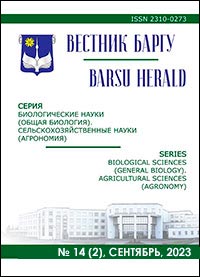INHERITANCE OF PLANT HEIGHT OF INTRASPECIFIC F1 HYBRIDS OF WINTERAND SPRING RAPESEED (BRASSICA NAPUS L.)
Keywords:
winter and spring rapeseed; F1 hybrids; plant height; parental forms; lodging resistance; inheritance; degree of dominance; degree of heterosisAbstract
The article presents the results of research that has been carried out during 2020—2021 to study of F1 hybrids
of winter and spring rapeseed (Brassica napus L.) derived from crosses between varieties (lines) and samples differing
in height of plants of parent forms. The negative true heterosis was observed in 9.5 % of the studied combinations of
winter rapeseed, i.e. the studied indicator was deviated towards a smaller parent. The negative competitive heterosis
(hybrids that were inferior in height to the control variety Leader) was noted for 78.6% of hybrid combinations,
hypothetical one — for 33.3% (hybrids that were inferior to the average height of plants of parental forms). The
spring rapeseed lines used in crosses showed negative hypothetical (25 % of hybrid combinations of their total number), Topaz × No 15A-2 and №111/4 × Veras. Compared with all studied combination, the maximum positive true heterosis
(40.9—41.8 %) was observed for Veras × №10A-2, No C62/67 × No 15A-2, №111/4 × No 10A-2, No 87/13-1 × No 15A-2.
It was found that the largest number of short-stemmed F1 hybrids with a positive degree of dominance was obtained
when using the Imperial winter rapeseed variety as the maternal form and sample No 20A-1 as the paternal one. When
using the spring rapeseed sample No 10A-2 as the maternal form, low-growing F1 hybrids with plant height from 92,2
to 103.7 cm were obtained, as well as when using short-stemmed samples as the paternal form: No 20A-2 (100.9—
107.5 cm), No 15A-2 (93.9—104.9 cm) and No C62/67 (108.2—109.6 cm).
Table 2. Ref.: 13 titles.
Downloads
Published
Issue
Section
License
Copyright (c) 2023 Вестник БарГУ Серия "Биологические науки. Сельскохозяйственные науки"
Это произведение доступно по лицензии Creative Commons «Attribution-NonCommercial» («Атрибуция — Некоммерческое использование») 4.0 Всемирная.
Авторы сохраняют за собой право заключать определенные договорные соглашения, касающиеся неисключительного распространения опубликованной версии работы (например, размещать ее в институциональном репозитории, публикация в книге) со ссылкой на ее первоначальную публикацию в этом журнале.





